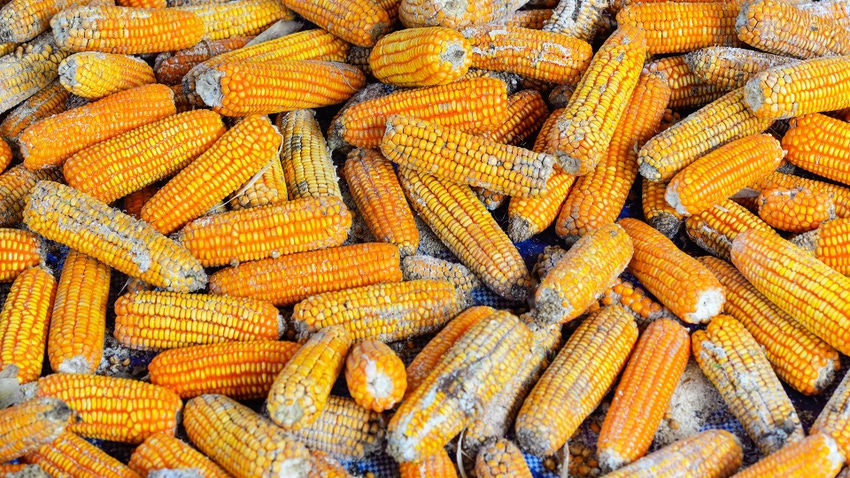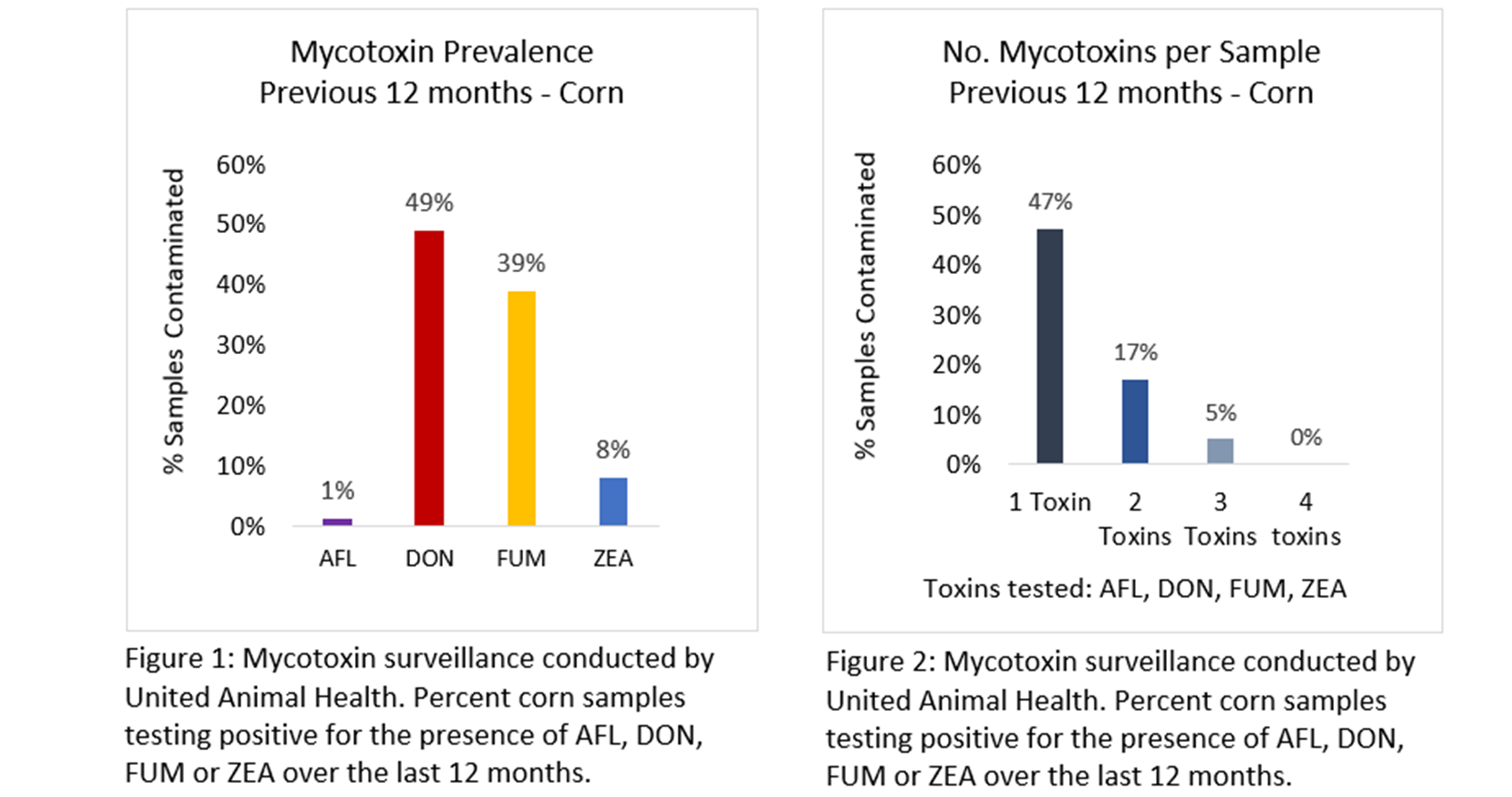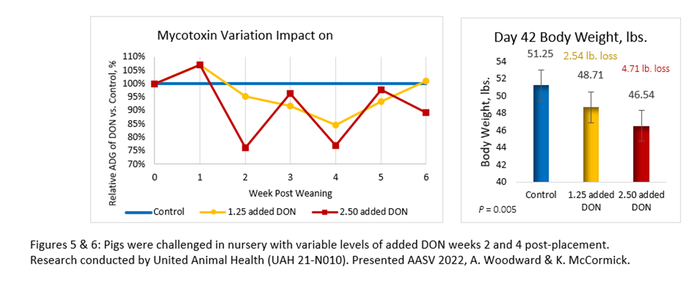Learn key mycotoxin insights from 6,500+ feed ingredient samples
Explore how understanding variable mycotoxin levels in feed can impact pig health and performance.
February 16, 2024

Ask the Experts: Key Insights from Over 6,500 Feed Ingredient Samples
Managing risks of mycotoxicosis is a critical step in protecting animal health and performance. Effective mycotoxin management plans include proper surveillance to determine mycotoxin presence and quantities. And, while sample results can provide guidance in management strategies, it is important to consider results in context when managing risks of mycotoxins in feed.
Since 2010, United Animal Health has conducted more than 100 animal trials to evaluate the impacts of mycotoxicosis, and routinely surveils more than 6,500 feed ingredients for the presence and quantities of mycotoxins. This has uncovered insights into the presence of mycotoxin variation in feed ingredients, as well as the impact this variation can have on pig health and performance.
A conversation with Riley Backs, Feed Research Supervisor, United Animal Health, and Katherine McCormick, M.S., Research Associate II, United Animal Health, reveals key insights into mycotoxin variation detected through sample surveillance, as well as a greater understanding of how variable mycotoxin levels in feed can impact pig performance.
Q: You’ve performed mycotoxin testing on more than 6,500 samples of feed ingredients over the last 12 months. What have you and your team learned during this time?
Riley : Consistent, routine sampling of feed ingredients is crucial to monitoring mycotoxin contamination throughout the year. All samples analyzed for mycotoxins at the United Animal Health laboratory showed some level of contamination in at least one of the four major mycotoxins – aflatoxin, fumonisin, vomitoxin, or zearalenone. Although degree of contamination between states and regions may vary, 49% of samples reported at least one mycotoxin above advisory levels with another 30% of these reporting two or more.

Photo submitted by United Animal Health.
Q: As you analyze sample results, how much do mycotoxin levels vary from the same mill locations over time?
Riley: Every mill is different and will experience unique trends making it difficult to quantify contamination of individual mycotoxins. We do tend to see an increase in variation when mixing previous year’s corn with new harvest, as well as when there is a higher prevalence of fines and “bees wings” in emptying bins in late summer / early fall. Just because mills and regions experience more consistent mycotoxin contamination below advisory levels, this does not mean that these areas are immune to incidences of harmful mycotoxin levels. Many feed ingredients, especially whole corn, are not equally contaminated throughout so it’s important to continue monitoring for mycotoxins year-round to capture any potential hotspots of contamination.

Photo submitted by United Animal Health.
Q: We have seen variation in mycotoxins across geographies and even within the same mill locations over time. Has any work been done to understand just how much toxin levels may vary within the same loads of ingredients?
Katherine: Research by United Animal Health was conducted to better understand the potential variation of mycotoxin presence and quantities within individual loads of delivered ingredients. Results (Figure 4) showed significant variation within a single load of an ingredient considered to have “clean” levels of mycotoxins. As average levels of delivered ingredients increase, the variation in detected levels of mycotoxins also increase exponentially.

Photo submitted by United Animal Health.
Q: As you and your team continue to research the impacts of mycotoxins on animal health and performance, what have you learned regarding how variation in mycotoxin levels in diets may impact the pig?
Katherine: In-vivo research conducted at United Animal Health has shown that DON over 1 ppm in nursery diets results in lost nursery performance, regardless of duration or pattern of exposure. Furthermore, even low levels of DON exposure for just 2-weeks resulted in costly performance lags and reduced body weight at end of nursery.

Photo submitted by United Animal Health.
Q: Based on what you’ve shared regarding mycotoxin prevalence, variation in mycotoxins and how this can impact health and performance, how can this information be used to help support effective mycotoxin management strategies?
Riley: Each sample submitted for testing provides only a brief snapshot of mycotoxin contamination levels. Prior analysis of feed ingredients may help predict future mycotoxin levels, but it does not provide a guarantee that current trends will remain, or that future mycotoxin threats have been avoided. Only with continual analysis can mills and producers gain a more thorough insight to mycotoxin threats, allowing them to position themselves on a proactive, rather than reactive stance.
Katherine: As Riley mentioned a sample submitted for mycotoxin analysis is just a snapshot of the mycotoxin contamination levels. It is imperative to regularly test ingredients and provide a representative sample of each delivered ingredient, to help provide the best information to make decisions on mitigation of mycotoxins. Even low levels of mycotoxins can cause a loss of performance, but also secondary health and gut related problems.
You May Also Like
.jpg?width=300&auto=webp&quality=80&disable=upscale)



